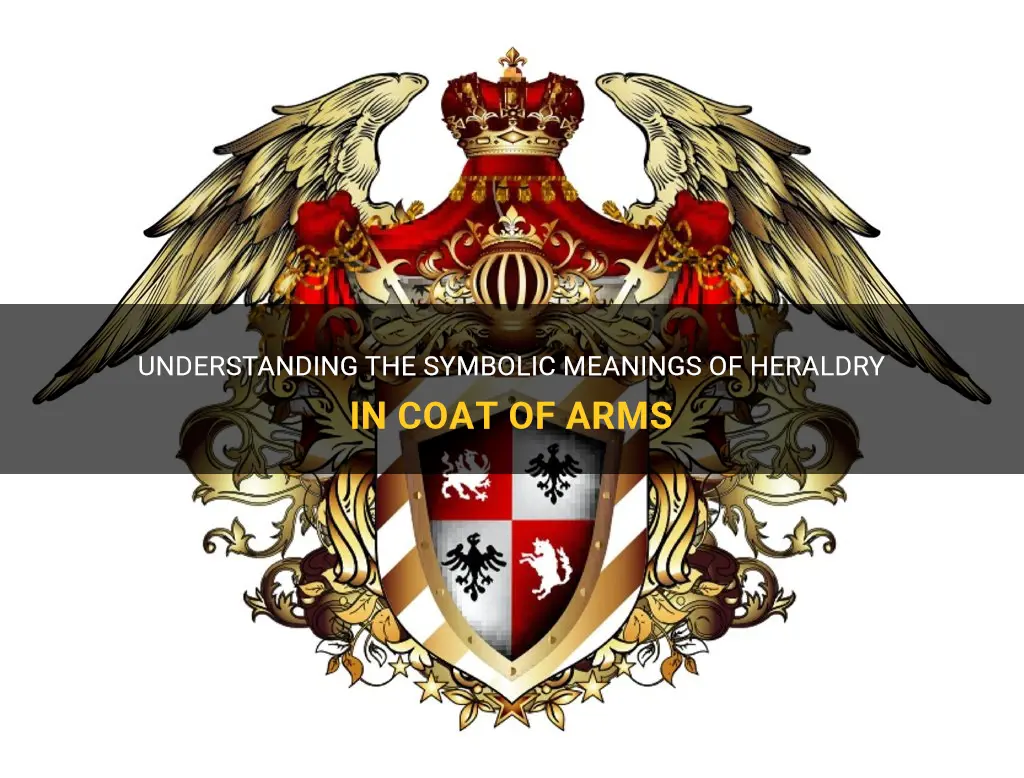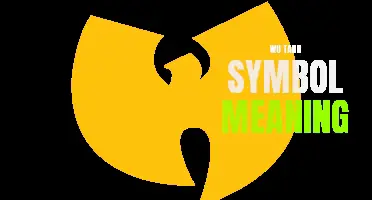
Heraldry symbol meanings have fascinated scholars and enthusiasts alike for centuries. The rich tapestry of symbols and colors used in coats of arms can tell stories of lineage, character traits, and achievements. These symbols not only serve as a form of identification but also as a visual language, conveying messages and establishing alliances. Exploring heraldry symbol meanings is like unraveling a secret code that unlocks a window into the fascinating history and culture of noble families. From the noble lion symbolizing strength and courage to the majestic eagle representing freedom and power, these emblems create a captivating world where history and artistry intertwine. Join me on a journey through the intricate world of heraldry and uncover the hidden meanings behind these enduring symbols.
What You'll Learn
- What is heraldry and what significance does it hold in symbols?
- How can one determine the meanings behind specific heraldry symbols?
- What are some common heraldry symbols and their respective meanings?
- Are there any cultural or regional variations in the meanings of heraldry symbols?
- Have any heraldry symbols evolved or changed in meaning over time?

What is heraldry and what significance does it hold in symbols?
Heraldry is a fascinating field that deals with the study and design of coats of arms, or heraldic symbols. These symbols have been used for centuries to represent families, organizations, and regions. The significance of heraldry lies not only in the visual appeal of these symbols but also in the historical and cultural context they represent.
Coats of arms first appeared in medieval Europe as a means to identify knights on the battlefield. These intricate designs were carefully crafted to reflect the bearer's family lineage, achievements, and ideals. Heraldry provided a means of instant recognition and distinction in the chaos of warfare, as well as a way to assert one's social status and lineage.
Heraldic symbols typically consist of a shield, divided into various sections called charges, which may include animals, plants, objects, or geometric shapes. These charges often have specific meanings associated with them. For example, a lion might symbolize strength and courage, while a fleur-de-lis could indicate nobility.
Beyond their use in battle, coats of arms were also displayed in everyday life. They adorned castles, tombs, and other important structures, serving as a visual representation of one's identity and social standing. Coats of arms were passed down through generations, with slight modifications made to reflect any changes in the family's status or alliances.
In addition to representing individuals and families, heraldry also played a prominent role in establishing the identity of organizations and regions. Kings, kingdoms, cities, and guilds developed their own heraldic symbols to assert their authority and sovereignty. These symbols often incorporated elements from the coat of arms of the ruling family or notable local figures.
The importance of heraldry in history cannot be understated. By analyzing coats of arms, historians can gather information about social hierarchies, political alliances, and cultural influences. They provide a glimpse into the past, helping us understand the complex relationships and power dynamics of different time periods.
Furthermore, heraldry continues to have significance in the modern world. Many families and organizations still use coats of arms or similar symbols to emphasize their heritage and values. They serve as a link to the past, connecting us with our ancestors and reminding us of our roots.
In conclusion, heraldry is an ancient art form that holds great significance in the world of symbols. These meticulously designed coats of arms convey not only visual appeal but also historical and cultural meaning. From identifying individuals on the battlefield to representing the authority of kings and organizations, heraldry has played a crucial role in shaping our understanding of the past. Today, it continues to provide a powerful link to our heritage and serves as a visual representation of identity and values.
Unlocking the Secrets of September: Its Meaning and Symbolism
You may want to see also

How can one determine the meanings behind specific heraldry symbols?
Heraldry symbols have been used for centuries to represent families, organizations, and countries. These symbols carry deep meanings and often tell a story about the entity they represent. However, the meanings behind specific heraldry symbols can vary depending on the culture and time period in which they were used. Here are some ways in which one can determine the meanings behind specific heraldry symbols.
Research the Coat of Arms: One of the most common forms of heraldry is the coat of arms. These shields often feature various symbols and colors that hold significant meaning. To determine the meanings behind specific symbols on a coat of arms, one can start by researching the family or organization associated with the coat of arms. Many families or organizations have detailed histories that explain the symbolism on their coat of arms.
Consult Heraldry Books or Databases: There are numerous books and databases dedicated to the study of heraldry. These resources often provide detailed explanations and interpretations of various heraldry symbols. By consulting these sources, one can better understand the meanings behind specific symbols. The College of Arms in London, for example, is an excellent resource for studying heraldic symbols.
Consider the Context: When trying to determine the meaning behind a specific heraldry symbol, it is important to consider the context in which it was used. Symbols can have multiple interpretations depending on their placement, color, and accompanying elements. For example, a lion can represent bravery, power, or royalty, depending on the context in which it is used. By understanding the cultural and historical context of the symbol, one can better interpret its meaning.
Seek Expert Advice: Sometimes, the meanings behind specific heraldry symbols can be challenging to ascertain without expert guidance. If you are struggling to determine the meaning behind a symbol, it may be helpful to seek the advice of a heraldry expert. These experts have studied heraldry extensively and can provide valuable insights into the symbolism behind specific symbols.
Examine Similar Heraldry Symbols: Another way to determine the meanings behind specific heraldry symbols is to compare them to similar symbols used by other families or organizations. Many heraldic symbols are derived from ancient mythology, legends, or historical events. By examining the symbols used by similar entities, one can find patterns and similarities that shed light on the meanings behind the symbols.
In conclusion, the meanings behind specific heraldry symbols can be determined through research, consultation of resources, considering the context, seeking expert advice, and examining similar symbols. By understanding the symbolism behind these ancient and meaningful symbols, we can gain insight into the rich history and stories they tell.
The Meaning Behind the Box With X Symbol
You may want to see also

What are some common heraldry symbols and their respective meanings?
Heraldry symbols have been used for centuries to depict and represent various aspects of a person's identity, such as their family history, accomplishments, and personality traits. These symbols, often found on coats of arms and other heraldic devices, are steeped in tradition and bear significance in their meaning. Here are some of the most common heraldry symbols and their respective meanings:
- Lion: The lion is arguably the most well-known heraldic symbol, representing strength, courage, and leadership. It is often depicted in a rampant position, standing on its hind legs with its front paws raised.
- Eagle: The eagle is a symbol of nobility and power, representing lofty aspirations and an elevated status. It is often depicted with its wings spread wide, signifying protection and a watchful eye.
- Cross: The cross symbolizes faith, devotion, and spirituality. Variations of the cross, like the Maltese cross or the St. Andrew's cross, carry specific meanings related to religious affiliations or military orders.
- Fleur-de-lis: The fleur-de-lis is a stylized lily flower and has been associated with royalty, purity, and divine protection. It has its origins in ancient heraldry and is most commonly associated with the French monarchy.
- Griffin: The griffin is a mythical creature with the body of a lion and the head and wings of an eagle. It represents the combination of strength and intelligence, often associated with guardianship and wisdom.
- Crown: The crown is a symbol of authority, sovereignty, and kingship. Different variations of the crown can signify specific ranks or titles within the nobility.
- Shield: The shield is the central element of heraldic devices and represents protection and defense. The shape, color, and design of the shield can carry additional meanings and associations.
- Stars: Stars are often used to symbolize honor, achievement, and aspirations. Different arrangements and sizes of stars can convey different meanings, such as a single large star representing a person of great renown.
- Oak tree: The oak tree is a symbol of strength, endurance, and stability. It is often depicted with acorns, symbolizing fertility and new beginnings.
- Fish: Fish, particularly the salmon, are symbols of determination, knowledge, and transformation. This symbolism is derived from the natural behavior of fish, as they swim upstream against the current to spawn.
These are just a few examples of the vast array of heraldry symbols and their meanings. Each symbol carries its own history and significance, adding depth and storytelling to the coats of arms and other heraldic devices they adorn. Study of heraldry allows for a better understanding of the rich cultural and historical context behind these symbols.
The Deep Symbolism Behind Slipknot's Iconic Mask and Logo
You may want to see also

Are there any cultural or regional variations in the meanings of heraldry symbols?
Heraldry, the system of symbols and designs used to identify individuals and families, has a rich history dating back to medieval times. Each heraldic symbol has a specific meaning, and these meanings can vary depending on the cultural and regional context in which they are used.
Cultural variations in heraldry symbols are particularly evident in Europe, where different countries and regions developed their own unique heraldic traditions. For example, the symbols used in English heraldry are different from those used in French heraldry. In English heraldry, a lion symbolizes bravery and strength, while in French heraldry, a lion represents royalty and nobility. Similarly, the meaning of a chevron, a V-shaped symbol, can vary between countries. In English heraldry, a chevron symbolizes protection, while in German heraldry, a chevron represents military rank.
Regional variations in heraldry symbols can also be found within a single country. For instance, certain symbols may have different meanings in different parts of the United Kingdom. A thistle, a national symbol of Scotland, represents bravery and loyalty in Scottish heraldry, while in English heraldry, it can represent defiance and independence.
Furthermore, heraldic symbols can also have specific meanings within certain families or clans. These meanings are often passed down through generations and can differ from the commonly accepted meaning of the symbol. This adds another layer of complexity to the interpretation of heraldic symbols.
It is important to note that the meaning of heraldic symbols is not fixed or universal. Over time, the meanings of certain symbols can evolve or change completely. For example, the fleur-de-lis, a symbol associated with French royalty, was once a symbol of purity and innocence but later became associated with the Virgin Mary in Christian heraldry.
In conclusion, there are indeed cultural and regional variations in the meanings of heraldry symbols. These variations can be found across different countries, regions, and even within specific families or clans. Understanding the cultural and regional context is crucial for accurately interpreting the meaning of heraldic symbols.
The Hidden Power and Sacred Meaning Behind the Ankh Symbol: Exploring Its Rich Symbolism
You may want to see also

Have any heraldry symbols evolved or changed in meaning over time?
Heraldry has a rich history dating back to ancient times, and is often associated with the coats of arms and family crests of nobility. These symbols have long been used to represent families, organizations, and even entire nations. While many heraldic symbols have maintained their meanings throughout the centuries, there are some that have evolved or changed in meaning over time.
One such symbol is the fleur-de-lis, which is commonly associated with the French monarchy. It is a stylized lily or iris flower that has been used in heraldry since the 12th century. Initially, the fleur-de-lis symbolized purity and the Holy Trinity. However, over time, its meaning expanded to represent the French monarchy and became a symbol of royalty, power, and divine right. Today, the fleur-de-lis is still associated with French heritage and is often used in flags, emblems, and various forms of art.
Another heraldic symbol that has evolved in meaning is the lion. Lions have long been associated with strength, courage, and royalty. In heraldry, lions are often depicted in a rampant position, standing on their hind legs with their front paws extended. Originally, the lion symbolized bravery and nobility, but as heraldry spread throughout Europe, its meaning became more varied. Different countries and families began incorporating lions into their heraldic designs, and often added their own unique symbolism. For example, in England, lions were associated with the monarchy and represented the royal lineage, while in Scotland, the lion represented courage and bravery. Today, lions are still commonly used in heraldry and can be found in the coats of arms of many countries and organizations around the world.
One fascinating example of a heraldic symbol that has changed in meaning is the crescent. In Muslim heraldry, the crescent has long been associated with Islam and is a symbol of the Islamic faith. However, in European heraldry, the crescent initially represented the moon and was associated with the night, darkness, and the feminine. Over time, the crescent became associated with beauty and purity, and was often used to represent the Virgin Mary. Today, the crescent is often used in both Islamic and non-Islamic heraldry, and its meaning can vary depending on the context.
Overall, while many heraldic symbols have maintained their meanings throughout history, there are some that have evolved or changed in meaning over time. Symbols like the fleur-de-lis, lion, and crescent have all undergone shifts in their symbolism and are now associated with different ideas and concepts. This evolution of meaning is a testament to the ever-changing nature of heraldry and the importance of understanding the historical context of these symbols.
Frequently asked questions
A heraldry symbol is a design or emblem used in heraldry, the study and practice of designing and using armorial bearings. These symbols are used to represent individuals or families and are typically displayed on shields, banners, and other forms of identification.
Heraldry symbols represent various aspects of an individual or family's history, achievements, and traits. They can symbolize family lineage, occupation, virtues, bravery, or even geographical locations. Heraldry symbols often use animals, plants, mythical creatures, and geometric shapes to convey their meanings.
Interpreting heraldry symbol meanings can be complex, as symbols can have multiple interpretations depending on the context and era in which they were used. One way to interpret a heraldry symbol is by researching the historical significance of the symbol and its association with the individual or family. Consulting heraldic experts or reference books on heraldry can also provide valuable insights into the meanings of specific symbols.
Heraldry symbols vary across different cultures and regions. Each country or region has its own unique heraldic traditions, symbols, and meanings. For example, the use of lions in heraldry is commonly associated with royalty in European cultures, while dragons are often used in Asian heraldry to represent power and wisdom. It is important to consider the cultural context when interpreting heraldry symbol meanings.
Yes, heraldry symbol meanings can change over time. The meanings and significance of certain symbols may evolve or be adapted to reflect the changing values and beliefs of society. Symbols that were once associated with specific virtues or ideals may come to represent different concepts or lose their original meaning altogether. It is important to consider the historical context when interpreting heraldry symbol meanings to understand how they may have changed over time.







